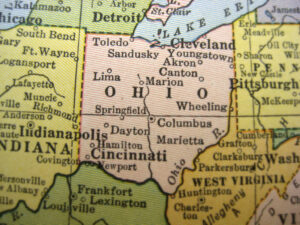 The aesculus glabra is a tree species that contains a poisonous fruit that Native Americans would call “hetuck,” meaning eye-of-the-buck due to its resemblance to a buck’s eyes. The tree was eventually termed an Ohio Buckeye and is the state tree. In this week’s blog we focus on the Midwest state of Ohio.
The aesculus glabra is a tree species that contains a poisonous fruit that Native Americans would call “hetuck,” meaning eye-of-the-buck due to its resemblance to a buck’s eyes. The tree was eventually termed an Ohio Buckeye and is the state tree. In this week’s blog we focus on the Midwest state of Ohio.
Business Climate
Ohio has the seventh largest state economy in the nation, based upon their 2013 GDP of $565 billion. The state’s success is a result their two leading industries; manufacturing and exporting.
Manufacturing is the state’s largest of twenty sectors, which accounts for $99.8 billion or 17.7% of the GDP. Ohio contributes 4.4% of America’s total manufacturing output, making them the 4th highest behind California, Texas, and Illinois. This sector currently employs over 673,000 people. Ohio leads the nation in production of plastics, rubber, fabricated metals, electrical equipment, and appliances.
The state has become the 9th largest exporting state in the nation due to its extensive railroad network, five international airports, and eight interstate highways. Ohio is geographically located within 600 miles of more than half of the U.S. and Canadian populations. In 2013, Ohio’s top exported commodity was machinery ($9.3 billion). Other top export commodities include vehicles, aircraft, electrical machinery, plastics, and optics. In 2012, over 16,000 companies exported from Ohio.
Taxes
Ohio is rated unfavorably on the 2014 State Business Tax Climate Index ranking at 39 out of 50. Their individual income tax (44th) and sales tax (30th) ranked poorly in comparison to other states. Governor John Kasich has tried to relieve the burden since taking office by creating tax reductions and reforms that reduced personal income taxes, created a new Earned Income Tax Credit, cut small business taxes in half and eliminated the death tax.
The state has a sales tax rate of 5.75% and the average local sales tax is an additional 1.36%. Cuyahoga County, the most populated county in Ohio, has the highest sales tax rate in the state at 8.00%. According to Ohio’s 2013 Comprehensive Annual Financial Report the state collected $8.6 billion of sales tax in 2013. In 2013, of Ohio’s $32.2 billion revenue almost $9.8 million came from income taxes, which was their largest source of revenue. The highest bracket for personal income taxes is 5.925%.
In lieu of a corporate income tax is the Commercial Activity Tax (CAT). Businesses with Ohio taxable gross receipts in excess of $150,000 in a calendar year must register for the CAT. The CAT must be filed quarterly if gross receipts are greater than $1 million or filed annually if less than $1 million. The tax rate is 0.26% on receipts above $1 million on a quarterly basis. All taxpayers registered for the CAT must also pay the Annual Minimum Tax (AMT), which before January 1, 2014 was a $150 flat rate. This year a new tiered system was enacted and the AMT can range from $150-2,600 depending on taxable gross receipts. The interesting (and somewhat unfortunate item) about the CAT is that companies are deemed to have nexus with the state (and therefore a requirement to file) even if they have no physical presence in the state. Ohio has enacted legislation with a bright line revenue threshold at $150,000. So we urge companies to pay attention to their Ohio based sales revenue.
Tax Credits & Incentives
The state offers various tax credits and incentives to qualified taxpayers and businesses who meet certain criteria.
Enterprise Zone Program: This program offers real property tax incentives for projects that are considered business establishments, expansions, renovations, or occupations within a specified zone. The program allows an exemption ranging from 60-75% of the assessed value on eligible investments in real property. A municipality or county will determine the geographic area of a designated zone before applying to the State Development Director for qualification. That zone must meet certain requirements. There are two types of zones in Ohio; Distress Based (full authority zones) and Non-distress Based (limited authority zones). As of 2013, there are more than 350 active zones all over the state. Most the bigger cities in Ohio, such as Cleveland, Columbus, and Cincinnati, are not within an active zone, but their surrounding areas do lie within them.
Job Creation Tax Credit Program: Qualified businesses may receive refundable credits up to 75% of withheld state income taxes, for a period up to 15 years if they meet a minimum payroll of $660,000. To qualify, businesses must either create 25 new jobs and pay a minimum of 150% of the federal minimum wage or 10 new jobs and pay a minimum of 400% federal minimum wage. The amount of credit received is determined by the number of jobs created, payroll generated by the project, and fixed asset investment in the project. The refundable tax credit can be used against a taxpayer’s CAT, insurance premiums tax, corporate franchise tax, or an individual’s personal income tax obligations. The program is to assist with projects that are economically sound and will benefit the people of Ohio by increasing opportunities for employment and strengthening the economy. However, if the business has received other state financial assistance they may receive a lower tax credit. Interested businesses must go through an application process via Jobs Ohio.
Research and Development Investment Tax Credit: The state offers a nonrefundable credit against the CAT for taxpaying corporations that invest in “Qualified Research Expenses.” The credit equals 7%of the amount of Qualified Research Expenses in excess of the taxpayer’s average investment in qualifying research expenses of the three prior years. Any unused portion may be carried forward up to seven years.
Random Ohio Facts
- Cleveland, Ohio is the home to the first traffic light which was placed into service on August 5, 1914.
- Ohio’s has the only state flag with a non-rectangular design.
- Of the 44 presidents of the United States, 7 were born in Ohio. *Guess which?
- Akron, Ohio was the first city to use police cars in 1899.
- The Cincinnati Reds were the first professional baseball team.
- Ohio native, dentist William F. Semple patented chewing gum in 1869. His original intent of gum was to clean the teeth and strengthen the chewer’s jaw.
Photo Credit: S. Wolfe via Flickr
*Ulysses S. Grant, Rutherford B. Hayes, James A. Garfield, Benjamin Harrison, William McKinley, William Howard Taft, and Warren G. Harding.













